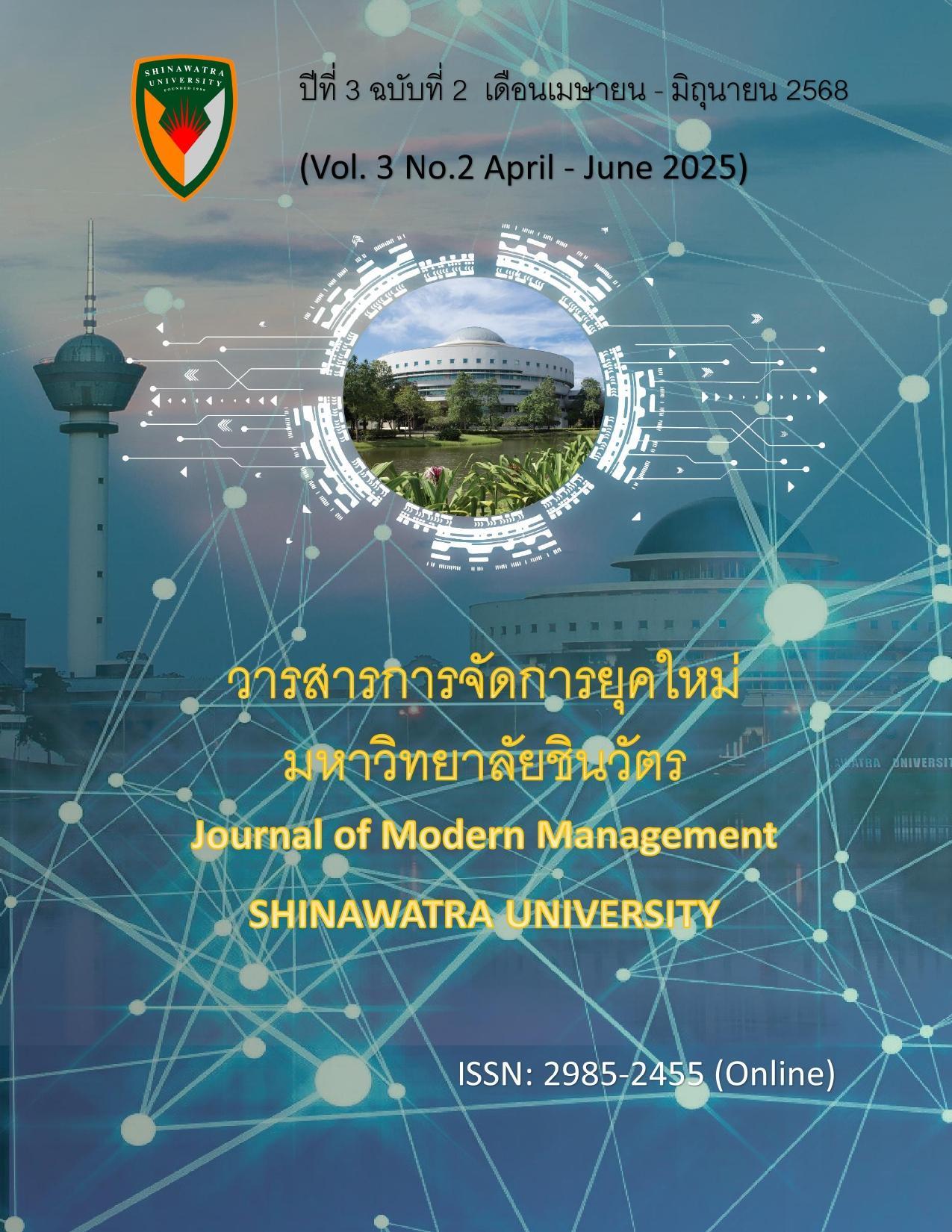Assessing the Nature of Financial Institution in South Sudan
คำสำคัญ:
Financial institution, Financial Products, Profitability, Accountability, South Sudanบทคัดย่อ
This article sought to investigate the nature of financial institutions from the viewpoints of South Sudan. This paper especially attempts to 1) To evaluate the impact of financial products in the financial institution in South Sudan, 2) To assess the impact of profitability in the financial institution in South Sudan and, 3) To evaluate the impact of accountability in the financial institution in South Sudan respectively. This article only makes use of descriptive research method and a convenience sampling technique was applied in this study. The hypothesis testing indicates that only financial products was accepted (.550) and profitability (.599) while accountability (.069) was rejected in this study as indicated by Sig. in regression model (table 18). In order to discuss the theoretical viewpoint and validate the developed framework, the system thinking method is also applied in the development of the financial institutions' conceptual framework from the perspectives South Sudan. In chapter four, the primary analytical tools included correlation analysis, frequency, percent, and descriptive analysis for the study's test variables as per the nature of financial institutions in South Sudan. Chapter five entails conclusion and recommendations coupled with limitations and future studies.
เอกสารอ้างอิง
Andenas, (2000), Mads ‘Liability for Supervisors and Depositors’ Rights – The BCCI and the Bank of England in the House of Lords’ 2000 (3), pp. 383-409.
Bharath, S.T., Sunder, J., and Sunder, S., (2008). Accounting quality and debt contracting. The Accounting Review, 83, 1–28.
Biddle, G.C., Hilary, G., and Verdi, R.S., (2009). How does financial reporting quality relate? to investment efficiency? Journal of Accounting and Economics, 48 (2–3), 112–131.
Blanco, B., Garcia Lara, J.M., and Tribo, J., (2015). Segment disclosure and cost of capital. Journal of Business Finance and Accounting, 42 (3&4), 367–411.
Bushman, R.M., Piotroski, J.D., and Smith, A.J., (2011). Capital allocation and timely accounting recognition of economic losses. Journal of Business Finance Accounting, 38 (1–2), 1–33.
Callahan, C.M., Smith, R.E., and Wheeler Spencer, A., (2012). An examination of the cost of capital implications of Fin 46. The Accounting Review, 87 (4), 1105–1134.
Cho, Y.J, (2015). Segment disclosure transparency and internal capital market efficiency: Evidence from SFAS, 131. Journal of Accounting Research, 53 (4), 669–723.
Christensen, H.B., Floyd, E., Liu, L.Y., and Maffett, M., (2017). The real effects of Mandated information on social responsibility in financial reports: evidence from mine-safety records. Journal of Accounting Economics, 64 (2-3), 284–304.
Dhaliwal, D.S., Li, O.Z., Tsang, A., and Yang, Y.G., (2011). Voluntary non-financial disclosure and the cost of equity capital: The initiation of corporate social responsibility reporting. The Accounting Review, 86 (1), 59–100.
Dou, Y., Ryan, S.G., and Xie, B., (2018). The real effects of FAS 166/167 on banks’ mortgage approval and sale decisions. Journal of Accounting Research, 56 (3), 843–882.
Dyreng, S.D., Hoopes, J.L., and Wilde, J.H., (2016). Public pressure and corporate tax behavior. Journal of Accounting Research, 54 (1), 147–186.
Ernstberger, J., Link, B., Stich, M., and Vogler, O., (2017). The real effects of mandatory quarterly reporting. The Accounting Review, 92 (5), 33–60.
Franco, F., Urcan, O., and Vasvari, F.P., (2016). Corporate Diversification and the cost of debt: The role of segment disclosures. The Accounting Review, 91 (4), 1139–1165.
Fuchs-Schundeln, N. & Funke, N. (2003). Stock market liberalizations: financial and macroeconomic implications. Review of World Economics, 139(4): 730-761.
Garcia Lara, J.M., Garcia Osma, B., and Penalva, F., (2016). Accounting conservatism and firm investment efficiency. Journal of Accounting and Economics, 61 (1), 221–238.
Gallego, F. & Loayza, N. (2000). Financial structure in Chile: macroeconomic developments and microeconomic effects, Central Bank of Chile Working Paper, No. 75.
Gelos, R.G. & Werner A.M. (2002). Financial liberalization, credit constraints, and collateral: investment in the Mexican manufacturing sector. Journal of Development Economics, 67(1):1-27.
Glen , J. & Singh, A. (2004). Comparing capital structures and rates of return in developed and emerging markets. Emerging Markets Review, 5(1): 161- 192.
Graham, J. (2001). Estimating the tax benefits of debt. Journal of Applied Corporate Finance, 14(1): 42-54.
Graham, J. & Harvey, C. (2001). The theory and practice of corporate finance: evidence from the field. Journal of Financial Economics, 60(5): 187-244.
Green, C.J., Murinde, V. & Suppakitjarak, J. (2003). Corporate financial structures in India. South Asia Economic Journal, 4(2): 245-273.
Greene, W.H. (2003). Econometric analysis. 5th ed. New Jersey: Prentice Hall.
Grullon, G., Michaely, R. & Swaminathan, B. 2002. Are dividend changes a sign of firm maturity? The Journal of Business. 75(3): 387-424.
Gujarati, D.N. (2003). Basic econometrics. 4th ed. Boston: McGraw Hill.
Gwatidzo, T. & Ojah, K. (2009). Corporate capital structure determinants: evidence from five African countries. African Finance Journal, 11(1): 1-23.
Harrison, A.E., Love, I. & McMillan, M.S. (2004). Global capital flows and financing constraints. Journal of Development Economics, 75(1): 269-301.
Harvey, C.R., Lins, K.V. & Roper, A.H. (2004). The effect of capital structure when expected agency costs are extreme. Journal of Financial Economics, 74(1): 3-30.
Huang, R., Marquardt, C.A., and Zhang, B., (2014). Why do managers avoid EPS dilution? Evidence from debt–equity choice. Review of Accounting Studies, 19, 877–912.
Konchitchki, Y., and Patatoukas, P. N., (2014) a. Taking the pulse of the real economy using financial statement analysis: implications for macro forecasting and stock valuation. The Accounting Review, 89 (2), 669–694.
Konchitchki, Y., and Patatoukas, P.N., (2014) b. Accounting earnings and gross domestic product. Journal of Accounting and Economics, 57 (1), 76–88.
Kraft, A.G., Vashishtha, R., and Venkatachalam, M., (2018). Frequent financial reporting and managerial myopia. The Accounting Review, 93 (2), 249–275.
Levi, S, and Segal, B., (2015). The impact of debt-equity reporting classifications on the firm's decision to issue hybrid securities. European Accounting Review, 24 (4), 801–822.
Nallareddy, S., and Ogneva, M., (2017). Predicting restatements in macroeconomic indicators using accounting information. The Accounting Review, 92 (2), 151–182.
Roychowdhury, S., Shroff, N., and Verdi, R., (2019). The effects of financial reporting and disclosure on corporate investment: A review. Journal of Accounting and Economics, 68 (2–3).
Shivakumar, L., and Urcan, O., (2017). Why does aggregate earnings growth reflect? information about future inflation? The Accounting Review, 92 (6), 247–276.
Shroff, N, 2017. Corporate investment and changes in GAAP. Review of Accounting Studies, 22 (1), 1–63.
Sletten, E., Ertimur, Y., Sunder, J., and Weber, J., (2018). When and why do IPO firms Alesina, Alberto and Lawrence Summers ‘Central Bank Independence and Macroeconomic Performance:
ดาวน์โหลด
เผยแพร่แล้ว
ฉบับ
ประเภทบทความ
สัญญาอนุญาต
ลิขสิทธิ์ (c) 2025 วารสารการจัดการยุคใหม่ มหาวิทยาลัยชินวัตร

อนุญาตภายใต้เงื่อนไข Creative Commons Attribution-NonCommercial-NoDerivatives 4.0 International License.





